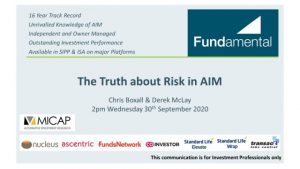Common AIM Myths Debunked!
AIM is often considered a higher risk market due to the increased volatility, but does heightened volatility really amount to greater risk?
From our perspective the purest definition of risk is the likelihood of a permanent loss of capital and, over the last 10 years, AIM’s larger companies have been better at delivering capital growth to investors than their UK main market peers..
There are many misconceptions and myths surrounding AIM. Here’s the truth on some of these below..
Your Capital Risk is at risk in AIM.. This is true
Like other equity markets, AIM carries capital risk and AIM has had a few high profile failures, including Conviviality, Patisserie Valerie and Silverdell. However, these are rare cases and the quality of companies and AIM’s governance has improved considerably over recent years. Although it used to have a wild west reputation the reality is that AIM is now a much more stable market, worth just over £100bn.
AIM Shares are Illiquid.. myth
Many AIM shares are less liquid than the main large market stocks, however, many main market companies are also far less liquid than similar sized AIM stocks. The value of AIM shares traded in August 2020 was over £5 billion with AIM’s largest company seeing £587 million of shares traded. Unless you are a large retail investor (£100m+), an institutional investor, or forced to sell during market sell-offs, liquidity risk should not be an issue.
Concentration is an issue for AIM.. can be true
Concentration can be an issue for some large AIM investment managers as AIM is designed to be a market for smaller companies and those managing significant assets for clients will risk owning too much of a single company. However, for Fundamental Asset Management this is not a concern. We are large enough to take advantage of scale but small enough not to have any concentration worries.
AIM is unregulated? ..Fake News!
AIM was established as part of the London Stock Exchange in 1995 and is a regulated market, although not to the same extent as the main market. There are firm corporate governance rules in place, and a variety of procedures and checks for constituent companies to follow. AIM is subject to the UK Market Abuse Regime and the majority of companies are subject to the rules of the UK Takeover Panel and the Companies Act.
AIM has only young and high-risk companies? Fake News!
AIM was designed for younger companies but has been around for 25 years. Many of those early business grew over time and the average market capitalisation is now around £130m. In fact, 20 companies have a market cap of over £1bn and the overall market value was £107bn at the end of August. The wide range of companies across numerous sectors means that investors can pursue different investment strategies within AIM.
Tax is the only reason to invest in AIM? Fake News!
AIM is one of the most successful growth markets in the world. AIM stocks pay no stamp duty, can be held in an ISA and many AIM companies also qualify for relief from Inheritance Tax through the Business Relief. The Numis Alternative Markets Index has returned 16.2% over the five years to 30 April 2020 (FTSE100 Index declined -4.9%), and dividends paid by AIM companies burst through the £1 billion mark for the first time in 2018. This makes for a much more enticing investment opportunity far beyond tax driven incentives.
Join me and the Fundamental Asset Team where we will be discussing more truths about risk in AIM.
Click the picture below to register for our session: The Truth about Risk in AIM
You can find out more about Fundamental Asset Management’s high performing AIM portfolio service, which has been delivering exceptional investment returns for more than 16 years, from the link here.


